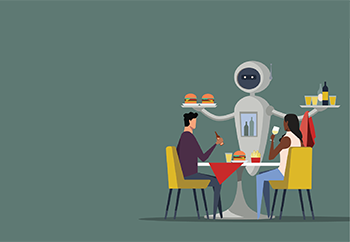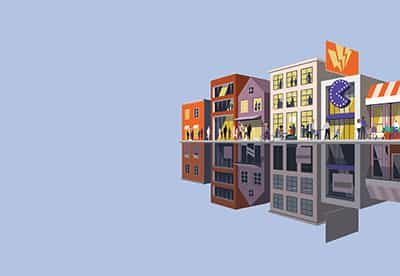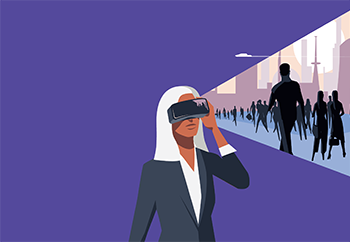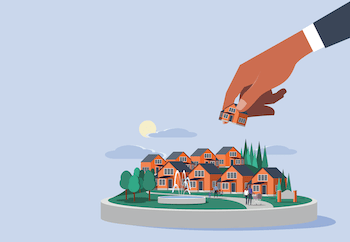
“I think it's certainly going back to normal. And I've heard on a number of occasions, “Hey, I'm having difficulty not bumping into tourists walking up and down Fifth Avenue.” That's my personal experience. Tourism is nearing pre-COVID levels, students are back in class. But the personas of who's entering offices specifically is very different now than what had been pre-COVID, based on how people work and what makes them productive.”
– Craig Leibowitz, Director, Innovation and Insight Advisory, U.S. at Avison Young
In this episode
A new, evolving story of our cities is unfolding, and only time, and our feet, will tell where trends go from here.
After two and a half years of disruption to every aspect of our lives, we are settling into a new normal in North American cities related to how we live, work, and play.
What are current trends showing for the state of cities and what might the future hold? What do CRE occupiers and investors need to prepare for?
The answers may lie in powerful data and decision tools like Avison Young’s Vitality Index.
In this episode of Changing Places, host Mariam Sobh discusses the return of people and places with guests Craig Leibowitz, Executive Director, Innovation and Insight Advisory, U.S. at Avison Young, and Michael Edwards, President & CEO of the Chicago Loop Alliance.
Highlights
- 13:52 – Craig Leibowitz shares how office and governmental visitation in cities like New York and Toronto have compared to areas such as education institutions, retail, transit, etc.
- 17:34 – Craig Leibowitz discusses how lockdowns affected the office economy, and the sector’s continued pursuit to remain competitive.
- 21:02 – Michael Edwards touches on how work from home trends have created a stronger desire to visit downtowns for leisure and socializing.
Click here to expand transcript
Speaker 1 [00:11] So a little weird seeing a lot of people downtown, especially since I've not come here in like three years. So the last time I was here, there were more people, it was more livelier and of late it's become a little more quiet, even though there are so many people. But yeah, I don't know. I like it and it's strange at the same time.
Speaker 2 [00:30] So when I think about coming back downtown after things have opened up, I guess it's refreshing to see more people out and about, which is good. I feel like a lot of the things were closed, and I don't know if that's just time of day or...
Speaker 3 [00:46] I come to downtown out of no choice, because I live in downtown and this is home for me. My apartment is right across the Ferry Building. But I honestly love living here. I love the restaurants. There's never doubt of finding fun places to go out with friends at night, whether it's weekends or weekdays, there's always something nice to do. I work from home, which is why I think I'm more rooted in downtown because this is home and workplace.
Mariam Sobh [01:10] No matter what you think about downtown, it's such an integral part of our built world that Petula Clark sing a whole song about it. Whether you're in Toronto, New York, or Berlin, the soul, the heartbeat of these cities lies within this epicenter of commerce, finance, entertainment, and housing. Maybe you still work and live downtown, or maybe you come downtown twice a week while working at a cabin in the country. Or maybe you only come downtown to see the touring production of that hot Broadway show or the opening of that impossible to get into restaurant. In that case, message me, because I want to go too.
The return to downtowns across North America since the pandemic is telling a very interesting tale and our footfall is telling that story. According to Reuters, a recent survey by the Partnership for New York City found that nearly 50% of New York City's office workers are expected to return to their downtown offices. Meanwhile, the CDC reports that findings from the Strategic Regional Research Alliance suggests that office workers returning to downtown is rising in Toronto, but their numbers are still down by 30%. However, the Toronto Transit Commission expects ridership to rise by 10 to 15% as more people return to their downtown offices.
I'm Mariam Sobh, and this is Changing Places. In order to understand how we got here, I'm going to chat with Craig Leibowitz, Executive Director, Innovation and Insight Advisory, U.S. at Avison Young about what he's seeing as we return to downtowns across North America and the changes we're seeing, which may further alter our relationship with the built environment through Avison Young's Vitality Index. Throughout this episode, we'll hear from Michael Edwards, President and CEO of the Chicago LOOP Alliance.
Craig Leibowitz, welcome to Changing Places. Craig, before we dive in, I want to know a little bit more about Avison Young's Vitality Index. Can you explain to us what it is?
Craig Leibowitz [03:24] Sure. I'll tell you what it is not. It is not a return to office report. What it is, a report that measures the vibrancy of cities and suburbs using cellphone data analytics, which becomes more of a behavioral as it is an economical report.
Mariam Sobh [03:45] Okay. For folks who aren't, let's say, in the industry, what would this index be for them? Do they even need to be concerned about it?
Craig Leibowitz [03:52] Its implications are really quite broad and vast, and the beauty of this report really is the more humanized nature in which cellphone data is measured and interpreted. For example, it measures where people are going, whether it's offices, transit stations, museums, what have you. So it really does measure and quantify where people have gone throughout the pandemic and where people are currently situated today, which is very broad implications, but it relates to the economy of cities, the economy of suburbs, and of course more granular analyses as it relates to what's happening in specific subsets of markets, if applicable, in the context of what's happening across North America.
Mariam Sobh [04:44] That's really cool to be able to use that technology to measure that stuff, I guess in real time.
Craig Leibowitz [04:48] Yeah. It gets refreshed on Fridays, so something to be mindful of and we get it on a four- day lag from our tremendous partner in Orbital Insight, one of a handful of data vendors who play in the mobility data space. We released the first versions of the Vitality Index just over a year ago. The first version of the Vitality Index just measured return to office rates across a handful of cities in North America. We expanded the index after Black Friday of last year to measure retail experiences as well as a number of different unique analyses of the data that's locational in a few different respects.
Mariam Sobh [05:28] What is the benefit for stakeholders in the real estate sector who use the Vitality Index?
Craig Leibowitz [05:34] How much time do we have? Implications are really quite broad, so across different personas. For example, if I work for a city governmental agency or a business improvement district, I'll want to know how my performance is in terms of visitation in that district and in the context of the broader economy. If I'm an office owner, I'll want to understand what return to office efforts are for my portfolio in the context of the market. If I'm an office occupier, I'm going to want to understand what my return to office efforts are in the context of other occupiers within my industry, but also in the context of what's happening within the market itself. So if I'm in New York City and I'm a bank, I want to understand what other banks in New York City are doing, but other banks across North America as well. And that's just the tip of the iceberg. We could probably go on all day.
Mariam Sobh [06:27] So, Craig, how do users interact with the index? Is it something anyone can access via Avison Young's website? Is it only for people that are in this sector like landlords and brokers?
Craig Leibowitz [06:38] There are really two versions of the Vitality Index. There's the public version, which includes all 4, 000 reference points or areas of interest included across those 52 markets, all property types. And that is available on the AY website. The private version includes really more granular analyses relating to properties, submarkets, and the actual foot traffic values.
Mariam Sobh [07:06] When it comes to data analytics, how does that play a role in relationship to the changing, shifting built world that we're in as well as downtowns we're rediscovering again? What would you say the role of data analytics is in all of this?
Craig Leibowitz [07:21] The broader commercial real estate industry has been very slow to adapt technology and their decision- making processes. And even to this day, I get surprised when I hear from really institutional occupiers and investors that they make some pretty massive real estate decisions almost on a whim. And those days are starting to go by way of the dinosaur and they're firmly in the rear- view mirror under most circumstances. By the way, I have a research background, so I'm a culprit here as well. So what we used to do is we used to take historical data that was overly macro and use that type of data or data analysis to inform decisions when in reality we're transitioning towards, as an industry, real time, predictive and micro analytics that isn't as simple as vacancy rates and rents, but integrates other potential datasets of which the mobility data referenced in the Vitality Index is at or near the top of that list.
Mariam Sobh [08:21] I wonder if using that data and information, because you can get so, I guess deep with it now, does it make you go down the rabbit hole and then be like, " Okay, this is just too much information. We need to kind of focus."
Craig Leibowitz [08:32] Every time I interact with someone who's also using the index, I hear something unique, which speaks to the dynamism of the reports, which you really won't find elsewhere, which can be a little bit daunting, mind you, but it really is meant to be simplified and also applicable to the masses, whether it's more macro or a little bit more micro.
Mariam Sobh [08:50] Well, how are members of the commercial real estate sector adapting to metrics like the Vitality Index versus the old ways of measuring footfall in urban centers? I know you kind of touched upon that. Are you seeing more folks eager to adapt to this new thing? Or is it like this generational thing where folks are like, " No, this is the way we're always going to do it?"
Craig Leibowitz [09:10] I think it's definitely the former. I think whenever I present the Vitality Index, I presented it north of 100 times, believe it or not, in various iterations to a number of different organizations, public, private, occupier, developer, and owner, it always engenders a really interesting dialogue, which gets our audience to really think, but also positions us to be really constructive stakeholders and form their decision- making processes, whatever that truly entails. So it's been really well received, as well received as I could have hoped or anticipated.
And what's really exciting here, too, isn't just the notion that it's real time, since it gets refreshed automatically on a weekly basis, but it's also predictive. So one example of that is you'll often hear an office CEO say, " Get back to the office, because your students are back in class." And using the Vitality Index, we could actually measure people or students who are returning to class through our education property type, which is referencing colleges and universities. And what we've noticed is it's back to normal today, which serves as a leading indicator for potentially return to office efforts in the future.
Mariam Sobh [10:23] Craig, I'm curious to know more about the different themes and trends you're seeing with the Vitality Index and what that means as our relationship to downtowns continues to shift and change. But before we get to that, let's hear from Michael Edwards, the President and CEO of the Chicago LOOP Alliance about what he's seeing in Chicago's LOOP.
Michael Edwards [10:42] I don't think any large city was really ready for the dramatic halting of the economy. So we were outpacing all of our numbers leading up to the pandemic in terms of hotel stays and number of employees and amount of residential development. And that all just stopped. We have pedestrian counters out and we were at 20% of the pedestrian volumes the weeks after the pandemic and the shutdown began. Well, so as we evolve since the pandemic, and we are victims of this too, we just assumed that the 350, 000 daily employees is what would lead the LOOP back. And that was sort of a miscalculation on our part because what's really leading them back now is not office workers, but the nighttime activity. And so it is difficult to get a restaurant reservation in the LOOP, well, after five o'clock, largely because we have nine theaters that generate a ton of business downtown. The students are all back 100% and there's 55,000 students just in the LOOP alone and residents. And residential development is off the charts in the LOOP. So everybody's coming back except for the office worker.
Mariam Sobh [11:54] Stay tuned for the next part. And just a reminder, Changing Places is a podcast brought to you by Avison Young that continues to explore and question our complex relationship with the built world around us. I'm your host, Mariam Sobh. I hope you're liking the show so far. If so, please share Changing Places with your friends.
Before we get back to my conversation with Craig Leibowitz, let's go back to San Francisco to hear what the folks think about our return to downtown.
Speaker 4 [12:22] For me, I think coming down to downtown is mostly about work. Sometimes I do have meetings, that's why I travel here. And meeting friends is also one of the reasons why I come here. So yeah, majorly work.
Speaker 5 [12:33] Coming downtown is a real mix, I mean, certainly for work. But downtown, it has so much to offer, not so much itself, mainly how adjacent it is to other stuff like Chinatown or just for me walking here. I live on the edge of the TL, the Tenderloin. So, it's very differentiated in a lot of ways. Even though driving through, you might think it looks all the same, but it has all ages, the elderly, the young and families, which often get segregated with the way the built environment is created nowadays.
Mariam Sobh [13:12] Now back to my conversation with Craig Leibowitz, Executive Director, Innovation and Insight Advisory, U. S. at Avison Young. Let's talk about the overall trends, Craig, that you've seen with footfall in major downtown areas like New York City or Toronto. How has it been in the last six months or so?
Craig Leibowitz [13:28] So just as context, we have to keep in mind what has driven those footfall or visitation levels. And really, when we think broader in terms of economies, at the top of that list is virus- related regulations or governmental reforms, which reforms everything from tourism to office visitation and so on. We've seen incremental upward pressure on visitation volumes both in New York City, Toronto, and actually in urban areas more broadly. Are they back to normal? No. What we've seen is that compared with the week preceding the lockdown, both markets are down about 20 to 25% based on the lack of visitation in the office in governmental areas of interest. But most other areas of interest have returned to normalcy, largely colleges and universities as measured by the education property type, and to a lesser extent healthcare, retail, and transit stations.
Mariam Sobh [14:32] So would you say overall things appear to be headed back to normal? Because pre COVID, I think footfall was at a high. I'm just kind of assuming that. And then, now, after COVID and lockdown, things are slowly coming back.
Craig Leibowitz [14:47] Yeah. And I think it's certainly going back to normal. And I've heard on a number of occasions, " Hey, I'm having difficulty not bumping into tourists, walking up and down 5th Avenue." That's my personal experience. Tourism is nearing pre- COVID levels. Students are back in class, but the personas of who's entering offices specifically, it's very different now than what it had been pre COVID based on how people work and what makes them productive. Executives have been going back to the office for some time now. It's just that their staff had them returning to the office, specifically those who may not be client facing, may be more productive remotely and so forth.
Mariam Sobh [15:27] Well, I wonder if at some point they're going to measure our sanity levels with work at home. Because I need my husband to go back to the office, I need my space.
Craig Leibowitz [15:35] That's it. Yeah, it's a very humanistic discussion, because you'll often hear sometimes that younger generations are inching to go back to the office because they crave that human interaction. But it's not just that, it's actually they're probably not as productive in New York City or Toronto where the rents are really high, you're probably jammed into your apartment like a sardine, and you're probably not all that productive there.
Mariam Sobh [15:58] Yeah, I can see that. What you're mentioning, seeing people going to the suburbs on these trains, what would you say with regards to those folks, are we seeing an uptick of people visiting their local downtowns, let's say, in the suburbs or in the countryside during the week versus going into the city?
Craig Leibowitz [16:14] We started to notice in the last three to four weeks, so really starting from August to present, is that there's been a convergence between urban locations and suburban locations. So one of the very popular refrains throughout the pandemic is that suburbanization has a returned after a 30- year hiatus and the data actually substantiates that. And that was true. So urban locations weren't recovering as quickly as those suburban and rural locations, but the prospects of greater return to office efforts plus just visitation across different unique areas of interest, whether it was sports arenas or airports, what have you, has caused that convergence to occur whereby urban locations have been radically outperforming suburban locations in recent weeks. And that's provided some of the contexts I shared earlier relating to comparatively low concerns relating to the health ramifications of the virus itself.
Mariam Sobh [17:13] Just to clarify, are you saying that urban areas are having more return to normal than suburban areas?
Craig Leibowitz [17:19] Yep, in recent weeks. So what we've noticed is that suburban areas are effectually back to normal. Urban locations, by and large are just a bit below pre lockdown or pre- COVID normalcy, but that gap is getting bridged in a big way and is expected to continue in the near future.
Mariam Sobh [17:37] So what do you think has driven the return to office efforts since the pandemic and how is that scope evolving?
Craig Leibowitz [17:44] From 2020 through 2021 and early 2022, the factors that influenced return to office were those governmental regulations informed by infection rates, the mode of transit people used to get to the office, so in other words, what was their exposure to others when commuting to and from the office, and the third consideration was the industry composition of cities. Today, the latter is certainly a primary influence and a secondary influence has become the economic landscape we are in and are entering in real time.
We have to keep in mind that the economy was not affected equally throughout the pandemic. So when the pandemic- induced lockdown occurred, it affected the discretionary segments of the economy, but not the office economy, which remained as competitive as it had been pre COVID and is by some measures, really more competitive. Now what occurred since is, of course, we're in a more hyperinflationary environment whereby the leverage is starting to steer towards employers and away from employees. So when employers say, " Get back to the office," their employees are incentivized to actually return at least on a hybrid basis. And really those employees should be incentivized to return because of the whole notion " out of sight out of mind" and the notion of productivity in the office versus remotely.
Mariam Sobh [19:08] You mentioned some of the office spaces have remained competitive, and I wonder is that because of the ability to create sort of flex spaces and co- working spaces? Because I think a lot of people who work from home may use some sort of co- working or flex space for meetings, maybe just to get out of the house. But in your data, what are you seeing among flex space providers and implications on the broader office industry?
Craig Leibowitz [19:31] We took some great strains towards dissecting not just what's happening in terms of markets or property types, but also within the office sector, who was driving those return to office efforts by industry segment? And what's reflected in the report is largely really fully- occupied office properties throughout the pandemic, which is not an easy task, but also the industry segmentation of a tenant makeup or occupier makeup, I should say, within the offices. And the number one performing industry, despite all the negative press based on some of the commentary from a handful of bombastic CEOs in the sector has been flexible office providers.
The reason for that is that office occupiers largely haven't effectuated their return to office solutions whereby they would have a better understanding of their short, medium, and longterm space needs. So the path of least resistance on that journey is actually to sign a shorter- term lease that could be found through any variety of different flexible office solutions, whether it's a third- party solution or a landlord- curated solution from which they can return to the office, get an understanding of what those needs are, and then acquire or dispose of office space.
Mariam Sobh [20:51] Craig, if we look ahead, what does the future look like for downtowns? Are they dead or reinventing themselves? Let's hold on to that thought for a moment and go back to Chicago to hear from Michael Edwards.
Michael Edwards [21:03] Work from home is a great idea. Eventually you want to go someplace else. Weekends are much busier than they have been before the pandemic. So I think people that are working from home realize that they just have to get out of their house in the same way that when they all work downtown, they wouldn't come downtown on the weekend because they were kind of tired of working in the LOOP. So before the pandemic, we were really a nine to five downtown. In fact, we did some activations into the evening just to kind of keep those 350, 000 workers downtown just a little bit longer. And really our economic development strategy was, if we could get 10% of those people, 35,000 people to buy one more beer, that would be like true economic development.
Mariam Sobh [21:42] Mariam Sobh: Craig, what does the future hold in store for football and our downtowns?
Craig Leibowitz [21:48] So I have good news and bad news. The good news is most areas of interests are just as active as they have been in the past, and we see it and feel it almost every day of our lives, whether we're going to grocery stores or we're going to sports arenas, which are just as crowded as they have been pre COVID. The counterpoint, unfortunately is that the office and governmental sectors have experienced a bit of a sea change and we haven't fully realized not just the extent to which those return to office and return to government efforts have come to fruition, meaning where's that equilibrium in terms of what the right balance is in terms of getting back to the office on a weekly basis, whether it's three days a week or four days a week or five days a week, from which there are pretty broad economic implications.
My estimate, my personal take is that if we're going to reset equilibrium in the next six months absent any unforeseen virus- related concerns, which, of course, has occurred each of the last three times I've made that statement. So knock on wood, it doesn't occur again. So we'll reach some form of equilibrium, if I were to guess, probably in the 30 to 35% below pre- COVID levels from which we're going to start to see more substantive boosts in terms of visitation just from office dwellers, but also a real boost to the ancillary industries that are relying upon office workers, such as dry cleaners and restaurants, delis and so forth. So the arrow's pointing up, but just a matter of what that line of demarcation is in the context of what's happening in terms of the office sector specifically.
Mariam Sobh [23:30] And finally, Michael Edwards.
Michael Edwards [23:32] Education, theater, visitors, tourism, all of those things are going to continue to be the things that are driving downtown. And it'll just be a more social place where people come to have maybe a bit more fun than they do to come to work. There's new office models, so places like Convene and WeWork. How people work downtown, may not be in the traditional office space, they may be their own entrepreneurs in some of these WeWork spaces. And so it's just going to be different. But I think at the end of the day, it's going to be the same. The economy has to continue moving. We're all social animals, believe it or not. We actually like being around each other. It's pretty boring to be standing in Grand Park if it's just you, but if there's a thousand people in there, all of a sudden you feel like you're part of something. And the LOOP is where people come together in Chicago to be part of something. That's not going to change.
Mariam Sobh [24:22] I'd like to thank Craig Leibowitz and Michael Edwards for sharing their expertise and insight into the state of downtowns. It's easy to assume that one story is the story when it comes to people coming back to their downtowns five days a week for work and on weekends. The world has shifted, everything has changed, behaviors have adapted in ways our cellphone data is showing, but is it the whole story? Are students and client- facing executives the future of North America's downtown corridors, while everyone else stays in the suburbs, commuting downtown on an as needed basis? Or will we gradually return to the places we remember so fondly or remember with a bemused half smirk?
If there's one thing that always remains true, it's that we need a reason to go downtown. Getting ready, driving into the city, or riding two trains, and then finally reaching your final destination can be taxing on the best of days. If you can stay home and livestream a concert, why go out? In the end, the human need to connect, to be seen, to identify with a large social group is why we'll always migrate to restaurants, concerts in the park and, yes, even pizza days at the office. Our feet are telling a story, a new story, an evolving story. It's a story I think will be with us for many years to come. How will it end? Only time and our feet will tell. I'm Mariam Sobh. This is Changing Places.
Changing Places is brought to you by Avison Young. Our producer is Andrew Pemberton- Fowler. Our sound engineer is Patrick Emile. Our producer assistant is Hugh Perkic. Additional production support is provided by JAR Audio.
Subscribe to receive Avison Young podcast updates
Related episodes from Avison Young podcast
-
 Made to serve: The rise and future of robot restaurants31 October 2022
Made to serve: The rise and future of robot restaurants31 October 2022 -
 From fashion to axe throwing: How the high street continues to evolve24 October 2022
From fashion to axe throwing: How the high street continues to evolve24 October 2022 -
 Through the looking glass: Into the emerging world of the metaverse19 September 2022
Through the looking glass: Into the emerging world of the metaverse19 September 2022 -
 From the mind of developers: A look at the complex world of planned communities15 August 2022
From the mind of developers: A look at the complex world of planned communities15 August 2022




